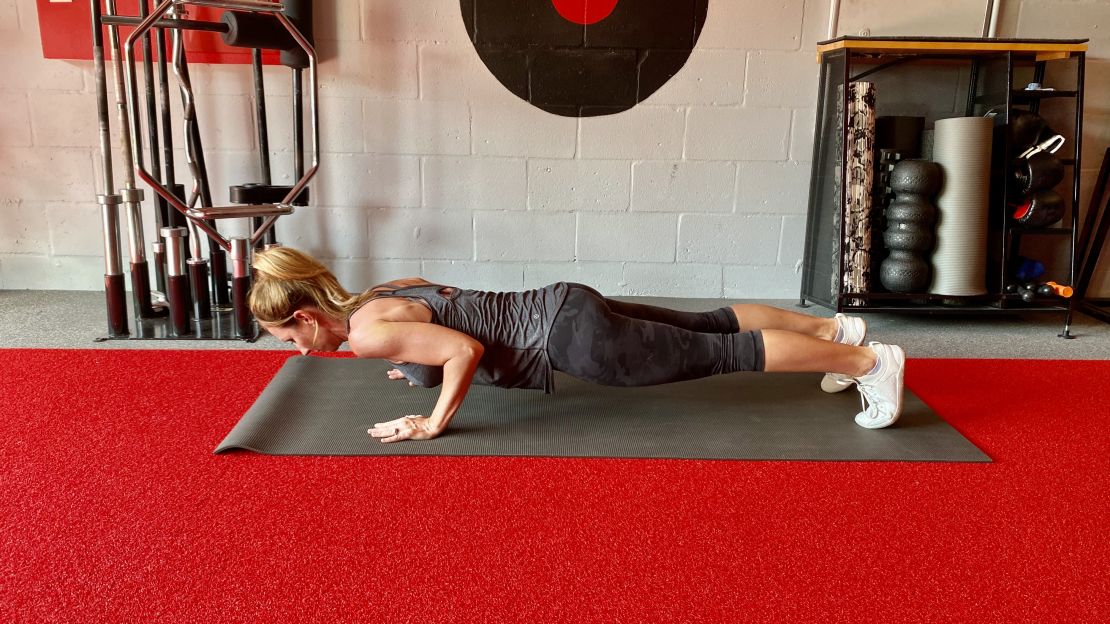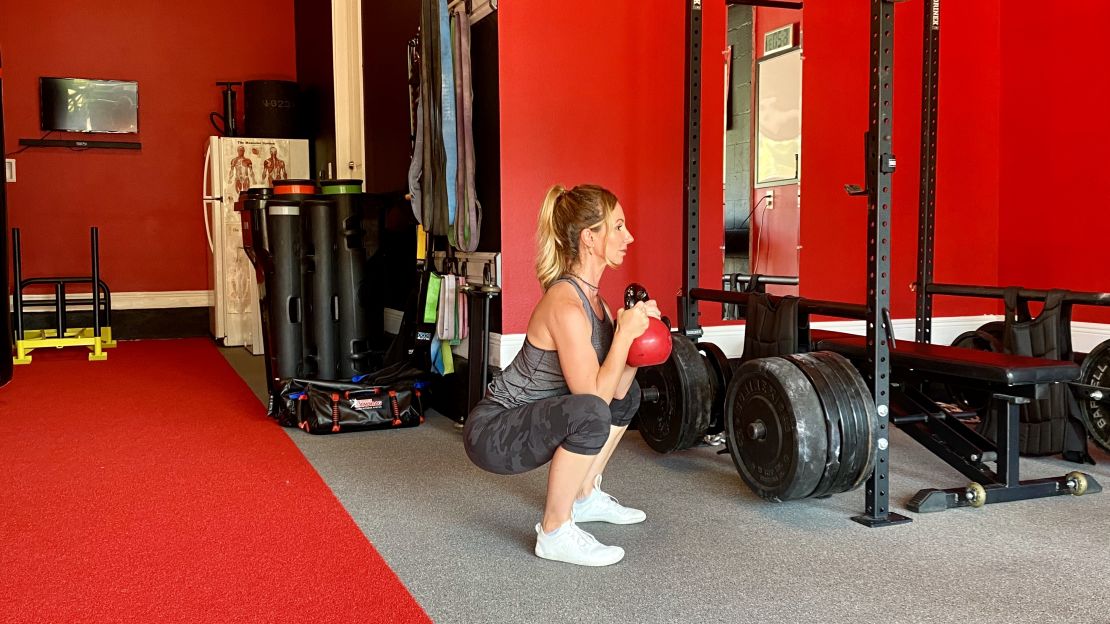Editor’s Note: Join Dana Santas for a seven-part series to learn how to reboot your workout routine — and stick with it. Here’s Part VI.
Now that we’re six weeks into our series, we’ve laid a solid foundation for a consistent workout program that includes mobility, strength and cardiovascular exercises. If you missed previous installments, go back and check them out, starting with Part I.
Up until this point, we’ve focused on moderate-intensity workouts that employ body-weight movements, free weights and steady-state aerobic activities. Today’s article explores how to effectively ramp up our workouts with high-intensity training.
READ MORE: How to reboot your workout routine: Let’s set the foundation
What is high-intensity exercise?
High-intensity training is generally characterized as a training style that involves periods of exercising intensely with an elevated heart rate alternated with recovery periods. It’s typically done in shorter workouts with body-weight exercises, but with the right technique, you can also effectively use weighted resistance, which we’ll cover below.
You might be wondering how you know you’re training at a “high” intensity. There are three standard measures:
- Percentage of maximum heart rate: Your maximum heart rate is the maximum amount of times your heart should beat per minute. To calculate your maximum heart rate, subtract your age from 220. Anything within 80% to 90% of your maximum heart rate is considered high intensity. Consequently, wearing a heart rate monitor will help you gauge your target zone.
- Rate of perceived exertion: This is exactly what it sounds like — based on your own perception, you rate your level of exertion on a scale, usually from one to 10. Matching the scale to your heart rate, you will want to be around an eight or nine.
- Talk test: High intensity means you aren’t able to say more than a word or two at a time due to a feeling of near breathlessness. That said, you shouldn’t feel unable to talk at all or unable to catch your breath — just on the edge.
READ MORE: Master body-weight movements: How to reboot your workout routine
High-intensity workout formats
Although some exercises, like sprinting or plyometrics (jump training), naturally lend themselves to driving up your heart rate, it’s more about the format that makes your workout “high intensity,” not so much the exercises themselves.
HIIT: High-intensity interval training is aptly named for its use of high-intensity exercise intervals broken up with periods of rest or active recovery. This is the most common form of high-intensity training, essentially serving as an umbrella term covering all specific styles, like the ones that follow.
Tabata: Tabata drills, created by Japanese scientist Izumi Tabata, consist of the same exercise performed through eight rounds of 20 seconds of activity and 10 seconds of rest for a total of four minutes.
Boxing: Because of boxing’s intense three-minute round, one-minute rest formula, it technically also falls into the HIIT category.
HIIT-style group fitness: Both CrossFit and Orangetheory classes employ elements of HIIT. CrossFit’s daily workouts often include intense intervals of exercises done at high speeds and/or high quantities. And Orangetheory classes include a focus on maintaining an “orange level” heart rate (84% to 91%) during intervals of high-intensity exercise.
READ MORE: Strength training with free weights: How to reboot your workout routine
Why increase exercise intensity?
With all the health benefits of moderate-intensity workouts, you might be wondering why increase the intensity? That’s a great question!
The biggest advantage of high-intensity training is efficiency. This type of workout delivers maximal calorie and fat burning in minimal time.
A 2015 study compared calories burned during HIIT, weight training, biking and running for a duration of 30 minutes. The research showed that HIIT burned 25% to 30% more calories than the other forms of exercise. What’s more, because the HIIT workout consisted of 20 seconds of exercise followed by 40 seconds of rest, the participants doing HIIT were only actively exercising one-third of the time as the steady-state running and biking participants.
Despite a low time commitment, HIIT is highly effective at fat burning, additional studies have found. Participants of one such study who did not alter their diets but performed 20-minute HIIT workouts three times per week saw an average 17% reduction of visceral fat in 12 weeks.
Less time commitment, more results. Sounds too good to be true, right?
Fact is, as the studies have shown, HIIT is a very effective means of exercise. However, there is a reason I waited until Part VI of VII in our series to cover it. The dangers of jumping into this type of training too fast, with too-advanced exercises can outweigh the benefits.
READ MORE: Get moving faster with cardio: How to reboot your workout routine
Risks vs. rewards
With all of HIIT’s advantages, it’s important to consider the risks. Even short spurts of high-intensity exercise are exhausting. And as you get tired, it becomes more challenging to properly execute exercises. This is especially true if you’re new to exercising, have recently taken time off or are overweight.
As we covered in Part II, proper form is key to the safety and efficacy of any exercise. If you repeat poor form over and over, you create compensatory movement patterns that not only lead to chronic pain but also injury.
That leads me to the burpee, arguably the most common exercise used in HIIT workouts. Many experienced coaches and trainers — me included — have concerns regarding the burpee and its marketing as a be-all and end-all of HIIT training.
Although the burpee is considered a single exercise, it’s actually comprised of multiple exercises done dynamically. From standing, you squat down and put your hands on the floor, then jump your feet back into a plank, do a push-up, jump your feet back to your hands into a deep squat, then jump straight up with your hands overhead and land on the floor in your starting, standing position. And, in most HIIT workouts, you’re directed to do as many burpees as possible as fast as you can.
My friend Los Angeles-based trainer Ben Bruno trains many fit celebrities, including comedian Chelsea Handler and model Kate Upton. “Too many people believe faster is better when training, but when speed is the goal in workouts, form suffers,” he said. “And because the burpee is actually an advanced exercise masquerading as a beginner exercise, using burpees in high-intensity training inevitably leads to combining poor form with high reps … a recipe for injury.”
Bruno believes there are better ways to get the benefits of high-intensity exercise while mitigating the risks. I agree. Let’s look at a couple of ways you can safely and effectively integrate HIIT into your workouts.
Important note: As with any exercise program, consult your physician before starting. The safest way to practice high-intensity exercise is to monitor your heart rate and slow down if it elevates beyond your target zone. If you experience chest pain or difficulty breathing, stop immediately and seek medical attention.
READ MORE: Biking your way to better health: How to reboot your workout routine
HIIT workouts to try
Burpee alternative HIIT workout: By breaking down the push-up, squat and jump aspects of a burpee into individual exercises, you can focus your attention on good form with each move. Also, adding weight to the squats adds a strengthening element that, as we learned in Part III, increases your metabolic rate, burning even more calories throughout the day — not just during exercise.
Ten rounds of:
10 push-ups (descending by 1 each round: 10, 9, 8 … 1)
10 goblet squats (descending by 1 each round: 10, 9, 8 … 1)
15 jumping jacks (remains constant: 15 each round)
30 seconds of rest or less (try to decrease rest time as reps descend)

Remember that form is crucial! You’ll find specific instructions on how to perform push-ups in the second article of our series and goblet squats in the third article.

Select a weight for the squats that is challenging yet manageable through all 10 descending rounds.
Jumping jacks are performed from standing by jumping your legs out to the sides in a straddle position as you take your arms out and above your head so your hands meet (or come close) and then jumping your legs back together while bringing your arms back down to your sides.
As you get tired, you might need to modify the exercises to ensure safe, effective form. That may mean dropping to your knees during push-ups, decreasing or eliminating the weight in your goblet squat or slowing down the jumping jacks. That’s OK — always prioritize form over speed or weight!
Medicine-ball slam Tabata workout: The Tabata format is designed to work with virtually any exercise, so you can effectively use it with something as simple as jumping rope or body-weight squats. Personally, I like to leverage my high-intensity workouts as a means of releasing stress. I find it cathartic to slam a medicine ball into the ground or wall. For more on med-ball slams and using high-intensity exercise to blow off steam, check out this article.

Eight rounds:
20 seconds of med-ball slams
10 seconds of rest
Slamming a medicine ball is a core-focused, total-body exercise. Select the weight of your ball based on what you can safely raise overhead and slam hard enough to bounce and catch on each repetition. Don’t try to maintain the same rep count for every round; you will naturally slow down as you get tired. Just try to keep your form through however many slams you can achieve.
With high-intensity training, less is more and form is paramount! Even with all of its advantages, adding too much HIIT into your overall program could lead to burnout and injury. Ideally, leverage HIIT on days when you’re short on time, working it into your weekly training program, no more than a few times weekly.
Get CNN Health's weekly newsletter
Sign up here to get The Results Are In with Dr. Sanjay Gupta every Tuesday from the CNN Health team.
Remember that the point of this series is to help you create a well-rounded training program designed to safely and effectively meet your health and wellness goals.
To that end, recovery is an essential component of working out. That’s why we’ll be closing out our series next week by covering how and why recovery is the key to maximizing benefits and minimizing injury.
Dana Santas, known as the “Mobility Maker,” is a certified strength and conditioning specialist and mind-body coach in professional sports, and is the author of the book “Practical Solutions for Back Pain Relief.”




